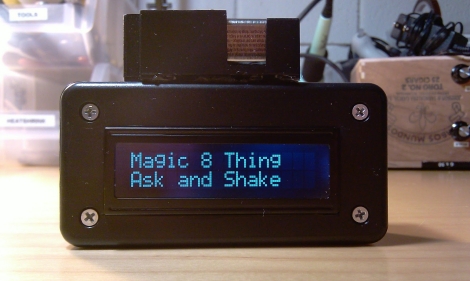
[Pete] was hard at work putting off a repair job for a friend, and wondered how much longer he could possibly procrastinate. With no fellow humans in earshot to which he could propose this question, he thought it would be great if he could ask a Magic 8-ball for an answer. Alas, he doesn’t have a Magic 8-ball, so he would have to build one if he wanted his answer.
Continuing to delay the repair job, he scrounged around his house and dug up an ATmega328 to control the 8-ball and a LCD panel to display the sage-like responses. He wanted the 8-ball to be as authentic in operation as he could, so he had to locate some sort of sensor that would register if the device had been shaken. With no accelerometer at hand, he opted to use a mercury tilt switch that he scavenged from an old thermostat. He wrote some software to display the responses from the original Magic 8-ball when shaken, then he threw the components together in a small plastic case.
As you can see in the video below, his Magic 8-thing works just like the original, sans the dark fluid and icosahedron. If you were wondering, he did finally ask the 8-thing whether he had procrastinated long enough on his initial task – the response: “Yes”
If you’re in the mood for more Magic 8-ball shenanigans, check out these posts!
[youtube=http://www.youtube.com/watch?v=edm9MSHHszk&w=470]















It would be awesome if you can power this using the same method those shake-up flash lights use.
i like how the mercury switch is actually big enough that you can hear it
sounds similar to a real magic8ball
You know they made these things in 1946 and they didnt even need an ATmega328 or a LCD display for that matter.
Cool tho.
it would have been cool if he attached the contrast to a pwm or digipot to make it fade in like a real magic 8 ball XP
Even better, use a smaller display and mount it in an old 8ball shell.
That is what I made recently for a friend of mine for his birthday: http://www.youtube.com/watch?v=3_OiARQenzs